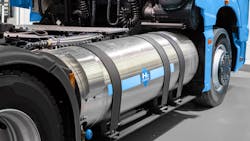Feds help fund freight decarbonization projects from coast to coast
Looking to jump-start freight decarbonization, the White House is charging ahead with financial assistance for major alternative fueling projects across the U.S. that are part of the Biden administration's intent to make zero-emission transportation more tenable this decade.
The Department of Energy will fund electric vehicle charging infrastructure for medium- and heavy-duty vehicles for future zero-emission vehicle corridors. The DOE awarded $7.4 million to seven projects to develop the corridors. These include EV charging and hydrogen infrastructure across 23 states. The DOE and Department of Transportation also plan to offer more than $2 billion in grants for other decarbonization projects.
See also: Charging infrastructure holds back EV truck production, deployment
Through the Joint Office of Energy and Transportation, the White House announced that the DOE intends to fund a cleaner, safer, more affordable, and more reliable American-made EV charging network. In coordination with additional clean transportation announcements from the Federal Highway Administration and the White House, these funding measures are part of President Joe Biden's goal to build a national network of 500,000 EV chargers. Biden wants half of new light-duty vehicle sales to be EVs by 2030.
"A clean transportation sector requires vast investments across the entire industry, including to decarbonize the trucks that move our goods and building more charging ports to get those trucks from coast to coast," said U.S. Secretary of Energy Jennifer M. Granholm. "President Biden's historic clean energy laws are making it possible for us to get more EVs on the road by expanding charging infrastructure into underserved communities while reducing range and cost anxiety among drivers who want to go electric."
Decarbonized long-haul has a long way to go
Zero-emissions freight transport is currently achievable for regional operators, who return their equipment to the same depot they began the day. Those regional heavy- and medium-duty trucks can be charged overnight and returned to service the next day.
Studies by the North American Council for Freight Efficiency—based on its Run on Less-Electric demonstrations—found that nearly all medium-duty box trucks, delivery vans, and terminal tractors in use today could be electrified and fit into most fleet operations. NACFE's study also found that half of all Class 8 regional tractors are electrifiable.
Long-haul trucking is not yet ideal for electric trucks because of the enormous weight of batteries, which eat into potential cargo space, and the shorter range of the equipment (and longer charge times) compared to diesel and other internal combustion engine fuels.
See also: Cummins reveals X10 fuel-agnostic engine for 2026
A recent report from the American Transportation Research Institute found that electricity supply and demand needs for trucking are "enormous." The ATRI report noted that heavy-duty EV production comes with weight and price increase challenges for motor carriers. Truck charging requirements could potentially create what ATRI called the "truck parking 2.0" crisis.
"Carbon-emissions reduction is clearly a top priority of the U.S. trucking industry, and feasible alternatives to internal combustion engines must be identified," Srikanth Padmanabhan, president of the engine business for Cummins, said in response to the ATRI study. "ATRI's research demonstrates that vehicle electrification in the U.S. will be a daunting task that goes well beyond the trucking industry—utilities, truck parking facilities, and the vehicle production supply chain are critical to addressing the challenges identified in this research. Thus, the market will require a variety of decarbonization solutions and other powertrain technologies alongside battery electric."
Along with these federally-funded charging and fueling infrastructure projects, major trucking OEMs, such as Daimler Truck North America and Volvo Trucks North America, are developing their own heavy- and medium-duty truck charging infrastructure. Cummins is also developing more ways to power heavy- and medium-duty equipment with fuel-agnostic engine designs.
DTNA is leading a joint venture with NextEra Energy Resources and BlackRock Renewable Power to design, develop, install, and run a nationwide charging network for commercial battery-electric and hydrogen fuel-cell vehicles. Volvo Trucks, which was the first major OEM to go to market with its regional VNR Electric Class 8 tractor, offers heavy-duty charging at its dealer locations. It is also working to build public EV infrastructure in the Bronx, New York, home to some of the worst air quality on the East Coast.
Charging infrastructure is one of the biggest obstacles to decarbonizing the freight industry, according to John O'Leary, DTNA president and CEO. "Siting, permitting, and construction delays all mean current lead times are being measured in years—not weeks or months," he told industry media in January. "There's a lot of will in the regulatory and political arenas to make that happen. But as we all know, when you start talking about moving large megawatt lines of electricity around, building new substations, and things like that, it takes time."
Creating a zero-emission freight corridor
The DOE-funded projects announced this month would focus on electrification plans for essential and heavily trafficked domestic freight corridors, including those serving northern and southern California, the Eastern Seaboard, the Northeast, Southwest, and much of the Midwest.
The projects—administered by DOE's Vehicle Technologies Office and Hydrogen and Fuel Cell Technologies Office—look to advance Biden's decarbonization goals by building out medium- and heavy-duty EV charging and refueling infrastructure to reduce emissions from freight corridors and the depots, ports, and other facilities those corridors service, according to the White House.
See also: A look at Ram's first electric pickup
Selected projects support DOE's Justice40 priorities by demonstrating the impacts and benefits of these freight corridor plans on underserved communities. The projects would also help improve air quality in underserved areas of major American cities, including New York, Los Angeles, Houston, Chicago, San Francisco, Oakland, and Salt Lake City.
The selected projects are:
- Calstart: East Coast Commercial ZEV Corridor. This project would launch an intensive strategic planning effort to spur the deployment of commercial medium- and heavy-duty ZEV infrastructure by developing an East Coast Commercial ZEV Corridor along the I-95 freight corridor from Georgia to New Jersey.
- Cummins: MD-HD ZEV Infrastructure Planning with Focus on I-80 Midwest Corridor. This project would develop a two-phase MD-HD EV Charging and H2 Fueling Plan for the Midwest I-80 corridor serving Ohio, Indiana, and Illinois, to support 30% of the MD-HD fleet using ZEV technologies by 2035.
- GTI Energy: Houston to Los Angeles (H2LA) I-10 Hydrogen Corridor Project. This project would develop a flexible and scalable blueprint for an investment-ready hydrogen fueling and heavy-duty freight truck network from Houston to Los Angeles along I-10, including the Texas Triangle region. In the process, develop a methodology for future corridor plans across the country.
- Los Angeles Cleantech Incubator: First to Last Mile: Creating an Integrated Goods Movement Charging Network around the I-710 Corridor. This project would create a plan for innovative infrastructure solutions at industrial facilities and commercial zones along critical freight arteries feeding into Southern California's I-710 freeway. The project would explore how private sector fleets can establish an integrated network that leverages existing industrial and commercial real estate assets while benefiting municipalities and communities.
- National Grid: Northeast Electric Highways Study. This project would forecast electric charging demand at traffic stops on freight corridors across Maine, Massachusetts, New Hampshire, Vermont, Rhode Island, Connecticut, New York, Pennsylvania, and New Jersey to help inform a blueprint for future large-scale, least-cost deployment of commercial EV charging and serve as an exemplar for other regions.
- Rocky Mountain Institute: San Francisco and Bay Area Regional Medium-and Heavy-Duty Electrification Roadmap. This project would create a roadmap for charging infrastructure to support the complete electrification of three key trucking market segments—drayage, regional haul, and long haul—in the Bay Area of California.
- Utah State University: Wasatch Front Multi-Modal Corridor Electrification Plan—Greater Salt Lake City Region. This project would develop a community, state, and industry-supported action plan to improve air quality in the underserved communities most impacted by high-density medium- and heavy-duty traffic in the greater Salt Lake City region.
Funding supports improving EV charging
The Joint Office of Energy and Transportation this month also issued a funding Notice of Intent to address challenges to achieving an equitable clean transportation future by improving the charging experience for EV drivers and expanding charging infrastructure into underserved communities.
This funding looks to enhance EV charging resiliency, deploy charging plans for underserved communities, develop the workforce to implement these plans, increase commercial capacity for testing and certifying high-powered EV charges, and validate those high-powered charges for real-world performance and reliability.
With the funding, the federal government is attempting to help companies implement these various zero-emissions projects. The DOT and DOE are offering $2.5 billion in competitive grants to build out the alternative fueling infrastructure.
President Biden set a federal goal of 500,000 EV chargers across the U.S. by 2030 to support the light-duty EVs that could make up at least half of all new vehicle production by the decade's end.
About the Author
Josh Fisher
Editor-in-Chief
Editor-in-Chief Josh Fisher has been with FleetOwner since 2017. He covers everything from modern fleet management to operational efficiency, artificial intelligence, autonomous trucking, alternative fuels and powertrains, regulations, and emerging transportation technology. Based in Maryland, he writes the Lane Shift Ahead column about the changing North American transportation landscape.


